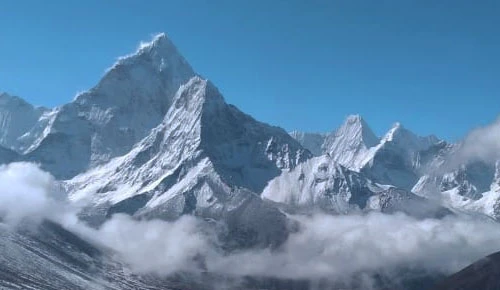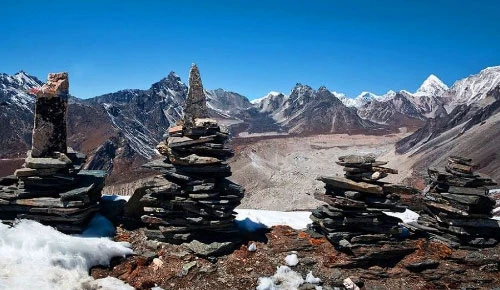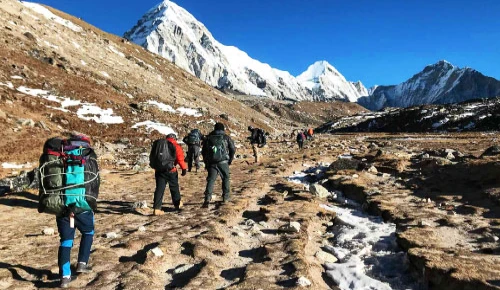Explore the Unique and Major Attractions of Everest Region
The Everest region of Nepal is one of the most popular tourist destinations in the world, attracting adventure seekers, nature lovers, and culture enthusiasts alike. The region is renowned for its stunning mountain landscapes and rich cultural heritage, and it is home to the world's highest peak, Mount Everest (also known as Sagarmatha in Nepali).
Tourism in the Everest is centered around trekking and climbing activities, with many visitors coming to hike to the base camp or attempt to summit the peak. The trek to the base camp is considered one of the most famous and challenging in the world and offers breathtaking views of the surrounding peaks, including Nuptse, Lhotse, and Ama Dablam.
Apart from trekking and climbing, the region offers a range of other activities, including cultural tours, hot air balloon rides, and helicopter flights. Visitors can visit the Tengboche Monastery, the largest and oldest monastery in the Khumbu region, or the Sherpa Museum in Namche Bazaar, which showcases the culture, traditions, and lifestyle of the Sherpa people.
Khumbu region is a unique and extraordinary destination that offers a truly unforgettable experience for visitors. Whether you are seeking adventure, cultural immersion, or simply a chance to connect with nature, the region has something to offer everyone. However, it is important for visitors to be mindful of their impact on the environment and local communities and to support sustainable tourism practices in the region.
Table of Contents
Lists of Major and Unique Sights of Everest Regions
The Everest region, which is located in the northeastern part of Nepal, is known for its stunning natural beauty and unique cultural heritage. It is the home of the highest peak in the world, Mount Everest (also known as Sagarmatha in Nepali), and attracts countless visitors every year who come to experience the incredible landscape and rich cultural history of the area.
The region offers a wealth of extraordinary and unique attractions that cannot be found anywhere else in the world. From the majesty of Mount Everest base camp to the rich cultural heritage of the Sherpa people, the region provides a truly unforgettable experience for visitors. Whether you are a seasoned trekker or a casual traveler, the Everest region is a must-visit destination for anyone seeking adventure and a deeper connection to nature and culture.
Everest is known for its unique and breathtaking experiences that can be life-changing. Here are some of the best and most unique things to experience on Everest:
Scaling the Summit
Scaling the summit in the Everest region is one of the most challenging and rewarding experiences a person can undertake. This iconic mountain, located in the Himalayas, is the highest peak in the world, standing at 29,032 feet tall. Climbing to the top of Everest is not just a physical challenge, but also a mental one. The high altitude and extreme weather conditions can take a toll on even the most experienced climbers. This is why proper planning and preparation are key to a successful ascent.
In order to reach the summit, climbers must navigate treacherous terrain and navigate their way through a series of stages, each more challenging than the last. Despite the dangers, many people are drawn to this mountain, as it represents a true test of one's strength and endurance. Whether it's for personal satisfaction or to prove that they have what it takes to take on this monumental challenge, scaling the summit of Everest is an experience unlike any other.
High-Altitude Trekking
High-altitude trekking in the Everest region is a once-in-a-lifetime experience for many trekkers. The breathtaking views of the world's highest mountain and the surrounding peaks are truly awe-inspiring. The trek involves walking along well-defined trails, crossing suspension bridges, and negotiating steep inclines. The journey is worth it as the vistas become increasingly stunning with every step.
The best time to do high-altitude trekking in the Everest region is during spring and autumn when the weather is relatively stable and mild. Whether trekkers are looking to summit the peak or just to witness its glory, they will not be disappointed by what they find in the Everest region.
Sherpa Culture
Sherpa culture is an integral part of the Everest region, as the Sherpa people have lived in the area for centuries. Sherpa culture is deeply rooted in Tibetan Buddhism and is characterized by strong family ties, hospitality, and hard work. The Sherpa people have a strong spiritual connection to the land, and they believe that their presence in the area is necessary to protect the region from evil spirits. The region is known for its majestic peaks, and the Sherpa people believe that the mountains are sacred and must be reversed.
The Sherpa people are known for their expertise in mountaineering, and they play a crucial role in guiding climbers to the top of Mount Everest. The Sherpa people are also known for their hospitality, and they welcome visitors to the region with open arms. They offer traditional food and lodgings to visitors, and their traditional dance and music are an essential part of the cultural experience in the region. The Sherpa culture is alive and well in the Everest region, and visitors can learn about their unique culture by visiting local villages and interacting with the friendly and hospitable Sherpa people.
Wildlife Watching
The region is also a haven for wildlife enthusiasts, offering opportunities to observe some of the most exotic species of the Himalayan region. The region is home to several species of animals, including snow leopards, Himalayan black bears, red pandas, and blue sheep. With the help of experienced guides, visitors can explore the natural habitats of these creatures and observe them in their natural environment.
Bird-watching is another popular activity in the Everest region, with over 200 species of birds, including the iconic Himalayan Monal, inhabiting the area. Visitors can enjoy a peaceful stroll through the lush forests, watching and listening to the colorful birds as they sing and soar through the sky.
Meditation and Reflection
The majestic landscapes of the Everest region offer a serene environment for meditation and reflection. With the quiet and pristine beauty of its rolling hills, glaciers, and high peaks, it creates a perfect atmosphere for inner peace and introspection. Visitors can find a peaceful retreat away from the fast-paced world, to spend time in quiet contemplation.
Whether sitting by the edge of a still lake or in the comfort of a quaint mountain lodge, the tranquil surroundings of the Everest region encourage visitors to let go of the stresses and worries of daily life, and simply be present in the moment. Whether practicing yoga, meditation or just sitting quietly, the environment of the Everest region provides the perfect backdrop for reflection and introspection.
The Khumbu Icefall
Khumbu Icefall is one of the most dangerous and challenging obstacles in the journey to reach the summit of Mount Everest. It is a constantly shifting river of ice that lies at the foot of the mountain, making the route to the top treacherous. The icefall is formed from glaciers that move down the mountain, breaking apart and creating massive ice blocks that are constantly shifting and collapsing.
Climbers must navigate their way through the maze of ice blocks, using ladders and ropes to cross crevasses and avoid falling ice. The Khumbu Icefall is a testament to the power and majesty of the mountain, and it is a symbol of the challenges that must be overcome to reach the summit of the tallest peak in the world.
Sunset and Sunrise Views
The Everest region offers stunning views of both sunsets and sunrises that leave visitors in awe. The golden hues of the sun setting behind the towering peaks of the Himalayas are a breathtaking sight, painting the sky with brilliant colors that reflect off the glaciers and snow-covered peaks. As the day turns to night, the stars come alive and create a sparkling sky that is unmatched.
On the other hand, watching the sunrise from the base of Mount Everest is a once-in-a-lifetime experience. The first rays of light illuminate the peaks, creating a breathtaking show of colors that change moment by moment. From reddish-orange to golden yellow, the sunrise in the Everest region is an unforgettable experience that should not be missed.
Mysterious Lakes
This region is known for its towering peaks and treacherous terrain, but one of its most enigmatic features is its mysterious lakes. These alpine lakes are located at high elevations and are surrounded by the majestic peaks of the Himalayas. They are not only a source of water for the local people but also hold a great deal of cultural and spiritual significance.
The crystal-clear water of these lakes is said to have healing properties, and the shores are believed to be sacred sites for meditation and prayer. Some of the most famous lakes in Everest regions are Gokyo Lakes, Imja Tsho (Lake Imja), Tsho Rolpa, Panch Pokhari, Barun Tsho, Lhamu Tsho, Nangpa Tsho, She Phoksundo Tsho, Bhairab Kunda, and Dudh Kunda.
Each of these lakes has its own unique characteristics; some are considered holy and revered by the local people, while others are famous for their stunning beauty and challenging trekking trails. These mysterious lakes not only offer breathtaking views but also serve as a habitat for various species of flora and fauna. The surrounding areas are also rich in cultural and religious significance, making them a popular destination for trekkers and adventure seekers.
Unique and Diverse Ecosystems
Everest region is home to a unique and diverse ecosystem, with a wide range of flora and fauna that are adapted to harsh high-altitude conditions. At lower elevations, the region is covered in lush forests of rhododendron, oak, and pine, which provide vital habitats for many species of birds and mammals. As you climb higher, the vegetation becomes sparser, and eventually gives way to the barren and windswept landscape of the upper slopes of the mountain.
The region is home to a number of specialized species, including the Himalayan tahr, which is well adapted to high-altitude grazing, and the snow leopard, which is found in the rugged and remote mountain ranges. The unique and diverse ecosystem of the Everest region is a testament to the incredible resilience and adaptability of life, and it is an important part of the global biodiversity heritage.
Stunning Views of the Himalayas
The Everest region is famous for its stunning views of the Himalayas, which are simply breathtaking. The region is surrounded by majestic peaks, including Mount Everest, Lhotse, Nuptse, and others. As you trek through the region, you are greeted with panoramic views of the mountain range that takes your breath away. The beauty of the Himalayas is truly mesmerizing and leaves a lasting impression on visitors. Whether you're enjoying a sunrise over the peaks or watching the sunset over the glaciers, the views of the Himalayas in the Everest region are unforgettable.
Colorful and Vibrant Monasteries and Museums
The monasteries and museums here are a testament to this heritage and offer a glimpse into the history and traditions of the region. The monasteries are known for their vibrant and colorful architecture, with intricate carvings and paintings adorning the walls.
The museums are equally stunning, displaying unique artifacts, traditional clothing, and other treasures from the past. Visitors can immerse themselves in the rich culture and history of the region by visiting these beautiful and vibrant monasteries and museums. Whether you are a history buff or simply enjoy exploring new cultures, the Everest region offers a truly unique and unforgettable experience.
Fascinating Culture and Traditions of the Sherpa People
The culture and traditions of the Sherpa people in the Everest region are fascinating and rich in history. Sherpas are indigenous people of the Himalayas who have lived in the area for centuries, and they have developed a unique way of life that is deeply connected to their environment. The Sherpa people are known for their hospitality and kindness, as well as their strong religious beliefs. They are also known for their expertise in mountain climbing, and many Sherpas serve as guides for climbers attempting to summit Mount Everest.
Sherpa culture is rich with traditional dances, music, and festivals, including the colorful Mani Rimdu Festival, which celebrates the victory of good over evil and the renewal of the world. These traditions and customs are deeply ingrained in Sherpa society and provide a window into the rich history and heritage of these fascinating people.
To Explore Everest
Here’s a list of some trekking and tour-guided packages through which you can easily access the paradigm of Everest. Nepal Trek Adventures is a leading trekking and adventure company in Nepal that offers a wide range of trekking, expedition, and helicopter tour packages in the Everest region.
We provide customized and well-planned packages to suit the needs and preferences of different travellers. NTA is dedicated to provide its guests with a once-in-a-lifetime experience in the majestic Himalayas. Some of the packages offered by us are:
SN | Trips | Duration |
1 | 4-5 hours | |
2 | 5 days | |
3 | 15 days | |
4 | 11 days | |
5 | 19 days | |
6 | 18 days | |
7 | 12 days | |
8 | 8 days | |
9 | 7 days | |
10 | 11 days | |
11 | 17 days | |
12 | 14 days | |
13 | 14 days |
Note: These are our regular packages. Please check the date, price, and duration. They are changeable and customizable according to the plan.
Conclusion
The beauty and uniqueness of Everest are unrivalled. The challenging climb to its summit, the breathtaking views of the surrounding landscape, the thrill of high-altitude camping, and the chance to experience the local culture are just some of the reasons why this region is a must-visit for adventure seekers and nature enthusiasts. Whether you're a seasoned mountaineer or simply looking to experience the beauty of the world's highest peak, Everest is a truly unforgettable destination that offers some of the most unique and exhilarating experiences in the world.





